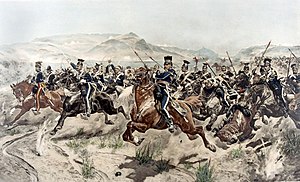
Back معركة بالاكلافا Arabic Balaklava döyüşü Azerbaijani Балаклаўская бітва Byelorussian Битка при Балаклава Bulgarian Batalla de Balaklava Catalan Bitva u Balaklavy Czech Slaget ved Balaklava Danish Schlacht bei Balaklawa German Balaklava batalo Esperanto Batalla de Balaclava Spanish
| Battle of Balaklava | |||||||
|---|---|---|---|---|---|---|---|
| Part of the Siege of Sevastopol (1854–1855) during the Crimean War | |||||||
 Charge of the Light Brigade by Richard Caton Woodville Jr. | |||||||
| |||||||
| Belligerents | |||||||
|
|
| ||||||
| Commanders and leaders | |||||||
|
|
| ||||||
| Strength | |||||||
|
20,000 British, 41 guns 7,000 French 1,000 Turkish |
25,000[1] 78 guns | ||||||
| Casualties and losses | |||||||
| 615[2] | 627[2] | ||||||
The Battle of Balaclava, fought on 25 October 1854 during the Crimean War, was part of the Siege of Sevastopol (1854–55), an Allied attempt to capture the port and fortress of Sevastopol, Russia's principal naval base on the Black Sea. The engagement followed the earlier Allied victory in September at the Battle of the Alma, where the Russian General Menshikov had positioned his army in an attempt to stop the Allies progressing south towards their strategic goal.[3] Alma was the first major encounter fought in the Crimean Peninsula since the Allied landings at Kalamita Bay on 14 September, and was a clear battlefield success; but a tardy pursuit by the Allies failed to gain a decisive victory, allowing the Russians to regroup, recover and prepare their defence.
The Russians split their forces. Defending within the allied siege lines was primarily the Navy manning the considerable static defenses of the city and threatening the allies from without was the mobile Army under General Menshikov.
The Allies decided against a slow assault on Sevastopol and instead prepared for a protracted siege. The British, under the command of Lord Raglan, and the French, under Canrobert, positioned their troops to the south of the port on the Chersonese Peninsula: the French Army occupied the bay of Kamiesch on the west coast whilst the British moved to the southern port of Balaclava. However, this position committed the British to the defence of the right flank of the Allied siege operations, for which Raglan had insufficient troops. Taking advantage of this exposure, the Russian General Liprandi, with some 25,000 men, prepared to attack the defences around Balaclava, hoping to disrupt the supply chain between the British base and their siege lines.
The battle began with a Russian artillery and infantry attack on the Ottoman redoubts that formed Balaclava's first line of defence on the Vorontsov Heights. The Ottoman forces initially resisted the Russian assaults, but lacking support they were eventually forced to retreat. When the redoubts fell, the Russian cavalry moved to engage the second defensive line in the South Valley, held by the Ottoman and the British 93rd Highland Regiment in what came to be known as the "Thin Red Line". This line held and repelled the attack; as did General James Scarlett's British Heavy Brigade which charged and defeated the greater proportion of the cavalry advance, forcing the Russians onto the defensive. However, a final Allied cavalry charge, stemming from a misinterpreted order from Raglan, led to one of the most famous and ill-fated events in British military history – the Charge of the Light Brigade.
- ^ Fletcher & Ishchenko: The Crimean War: A Clash of Empires, 159–160
- ^ a b Kinglake: The Invasion of the Crimea, V, p. 350. These figures are taken from Kinglake. Sources vary slightly as to the number killed, wounded, or taken prisoner.
- ^ Frederick Engels, "The News from Crimea" contained in the Collected Works of Karl Marx and Frederick Engels: Volume 13, p. 478.
© MMXXIII Rich X Search. We shall prevail. All rights reserved. Rich X Search